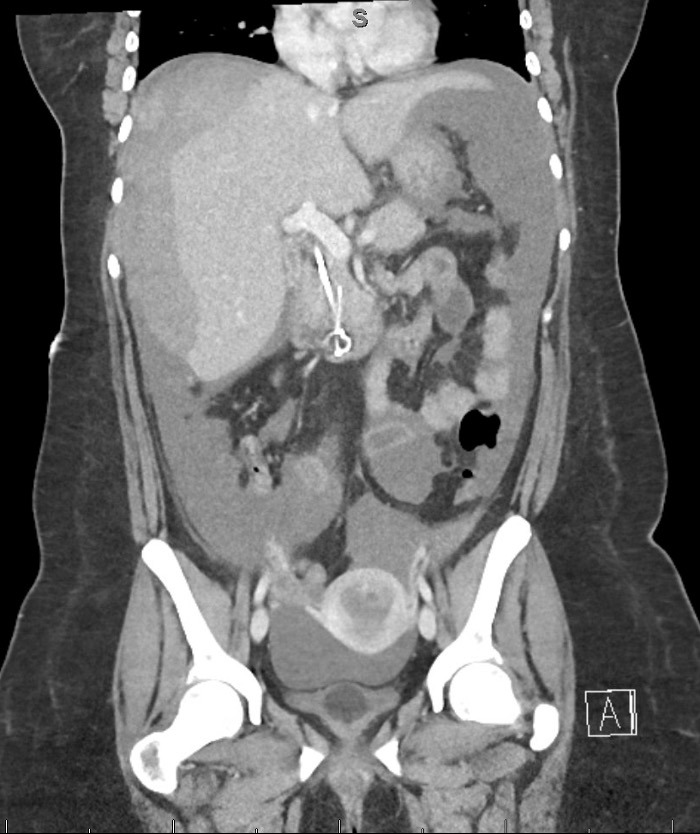Back
Poster Session C - Monday Afternoon
C0475 - First Trimester Subcapsular Hepatic Hematoma Following Endoscopic Retrograde Cholangiopancreatography
Monday, October 24, 2022
3:00 PM – 5:00 PM ET
Location: Crown Ballroom

Brandon Ganjineh
Virginia Tech Carilion School of Medicine
Roanoke, VA
Presenting Author(s)
Brandon Ganjineh, 1, Tarek Alansari, MD2, David M. Friedel, MD2
1Virginia Tech Carilion School of Medicine, Roanoke, VA; 2NYU Langone Medical Center, Mineola, NY
Introduction: Endoscopic retrograde cholangiopancreatography (ERCP) is commonly utilized to treat pancreaticobiliary diseases and is considered safe in pregnancy. We describe a case of ERCP indicated for choledocholithiasis in a newly pregnant patient which resulted in a very rare complication related to guide wire trauma.
Case Description/Methods: A 24-year-old female presented to the emergency department with right upper quadrant pain, fever, leukocytosis, and obstructive jaundice. Bloodwork revealed she was 8 weeks pregnant. Imaging studies showed acute cholecystitis and choledocholithiasis with a dilated common bile duct of 1.2 cm.
Therapeutic ERCP was performed with minimal use of fluoroscopy to reduce fetal exposure. Double wire technique was utilized and the bile duct was successfully cannulated with a 0.025 mm angled-tipped hydrophilic wire. Sphincterotomy was performed, followed by sphincteroplasty. The bile duct was swept with a 12 mm balloon but only one stone was extracted. To avoid further fetal fluoroscopy exposure, double plastic stents were placed into the common bile duct and a single pigtail plastic stent was placed into the pancreatic duct.
The following day, she became hemodynamically unstable. Labs suggested an improved cholestatic pattern and improved leukocytosis post ERCP decompression. Due to worsening hepatocellular injury and hemodynamic instability, a computed tomography angiogram was performed. A 3.9 cm subcapsular hepatic hematoma with capsular retraction and parenchymal distortion of the superior right hepatic lobe was found. Interventional radiology catheter embolization was attempted. Aggressive conservative management with blood transfusions and close monitoring successfully stabilized the patient. The patient ultimately had a spontaneous abortion and returned for an outpatient ERCP with biliary stent removal and stone extraction.
Discussion: Although a very rare complication, this case does highlight the possibility of angled-tipped hydrophilic guide wire hepatic trauma and clinically significant bleeding. When strongly indicated, ERCP should be performed in people who are pregnant, but exposure to fluoroscopy should be minimized. Similar cases hypothesize that liver injury is attributable to traumatic damage to the intrahepatic biliary tree and hepatic parenchyma by the ERCP guide wire.

Disclosures:
Brandon Ganjineh, 1, Tarek Alansari, MD2, David M. Friedel, MD2. C0475 - First Trimester Subcapsular Hepatic Hematoma Following Endoscopic Retrograde Cholangiopancreatography, ACG 2022 Annual Scientific Meeting Abstracts. Charlotte, NC: American College of Gastroenterology.
1Virginia Tech Carilion School of Medicine, Roanoke, VA; 2NYU Langone Medical Center, Mineola, NY
Introduction: Endoscopic retrograde cholangiopancreatography (ERCP) is commonly utilized to treat pancreaticobiliary diseases and is considered safe in pregnancy. We describe a case of ERCP indicated for choledocholithiasis in a newly pregnant patient which resulted in a very rare complication related to guide wire trauma.
Case Description/Methods: A 24-year-old female presented to the emergency department with right upper quadrant pain, fever, leukocytosis, and obstructive jaundice. Bloodwork revealed she was 8 weeks pregnant. Imaging studies showed acute cholecystitis and choledocholithiasis with a dilated common bile duct of 1.2 cm.
Therapeutic ERCP was performed with minimal use of fluoroscopy to reduce fetal exposure. Double wire technique was utilized and the bile duct was successfully cannulated with a 0.025 mm angled-tipped hydrophilic wire. Sphincterotomy was performed, followed by sphincteroplasty. The bile duct was swept with a 12 mm balloon but only one stone was extracted. To avoid further fetal fluoroscopy exposure, double plastic stents were placed into the common bile duct and a single pigtail plastic stent was placed into the pancreatic duct.
The following day, she became hemodynamically unstable. Labs suggested an improved cholestatic pattern and improved leukocytosis post ERCP decompression. Due to worsening hepatocellular injury and hemodynamic instability, a computed tomography angiogram was performed. A 3.9 cm subcapsular hepatic hematoma with capsular retraction and parenchymal distortion of the superior right hepatic lobe was found. Interventional radiology catheter embolization was attempted. Aggressive conservative management with blood transfusions and close monitoring successfully stabilized the patient. The patient ultimately had a spontaneous abortion and returned for an outpatient ERCP with biliary stent removal and stone extraction.
Discussion: Although a very rare complication, this case does highlight the possibility of angled-tipped hydrophilic guide wire hepatic trauma and clinically significant bleeding. When strongly indicated, ERCP should be performed in people who are pregnant, but exposure to fluoroscopy should be minimized. Similar cases hypothesize that liver injury is attributable to traumatic damage to the intrahepatic biliary tree and hepatic parenchyma by the ERCP guide wire.

Figure: Computed tomography of the abdomen revealed a hypodense subcapsular collection on the right side of the liver. The bleed continues inferiorly and medially. A plastic pancreatic stent and a plastic biliary stent are also visible.
Disclosures:
Brandon Ganjineh indicated no relevant financial relationships.
Tarek Alansari indicated no relevant financial relationships.
David Friedel indicated no relevant financial relationships.
Brandon Ganjineh, 1, Tarek Alansari, MD2, David M. Friedel, MD2. C0475 - First Trimester Subcapsular Hepatic Hematoma Following Endoscopic Retrograde Cholangiopancreatography, ACG 2022 Annual Scientific Meeting Abstracts. Charlotte, NC: American College of Gastroenterology.
